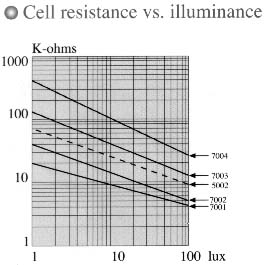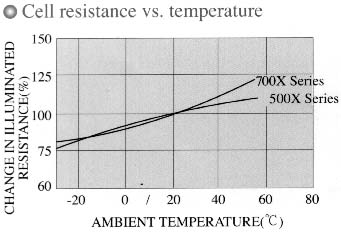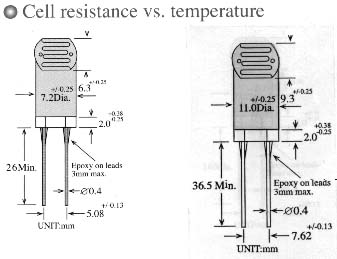
OCTSENS TECH CO., LTD.
Plastic
– coated Types (7P & 10P Types)
|
|
Maximum
Ratings |
Characteristics
E (at 25℃) |
|||||||
|
|
Applied |
Allowable |
Ambient |
Cell
Resistance A |
|
Response
Time at 10 lx D |
|||
|
|
Voltage |
Power |
Temperature |
10
lx (at 2856K) |
0
lx B |
C |
|
|
|
|
Type
No. |
at
25℃ |
Dissipation |
Ta |
Min. |
Max. |
Min. |
100~10
lx |
Rise
Time |
Decay
Time |
|
|
|
at
25℃ |
|
(K |
(K |
(M |
Type |
Type |
Type |
|
|
(Vdc) |
(mW) |
(℃) |
ohm) |
ohm) |
ohm) |
|
(ms) |
(ms) |
|
7002 |
200 |
150 |
-30~+75 |
4 |
20 |
0.5 |
0.65 |
55 |
20 |
|
7003 |
200 |
150 |
-30~+75 |
8 |
24 |
0.5 |
0.7 |
55 |
20 |
|
7004 |
200 |
150 |
-30~+75 |
15 |
60 |
0.5 |
0.7 |
60 |
25 |
|
7005 |
200 |
150 |
-30~+75 |
50 |
150 |
20 |
0.85 |
60 |
25 |
|
5001 |
350 |
400 |
-30~+75 |
8 |
16 |
0.3 |
0.6 |
55 |
25 |
|
5002 |
350 |
400 |
-30~+75 |
12 |
30 |
0.5 |
0.75 |
55 |
25 |
|
5003 |
350 |
400 |
-30~+75 |
12 |
58 |
1 |
0.75 |
55 |
25 |


A. Measured with the light source of a tungsten lamp operated at a color temperature of 2856K.
B. Measured 10 seconds after removal of incident illuminant of 10 lux.
C. Gamma characteristic between 10 lux and 100 lux and given by
![]()
Where R100, R10: cell resistances at 100 lux and 10 lux respectively
E100, E10: illuminant of 100 lux and 10 lux respectively
D. The rise time is the time required for the cell conductance to rise to 63% of the saturated level. The decay time is the time required for the cell conductance to decay from the saturated level to 37%.
E. All character is tics are measured with the light history conditions: the CdS cell is exposed to light (100 to 500 lux) for one to two hours.

OCTSENS TECH CO., LTD.
4F., No. 22, Ln 75, Sec. 2, Jhongjua Rd.,
Jhongjheng Dist., Taipei City 10065, Taiwan, R.O.C.
Tel: 886-2-23883573 Fax: 886-2-23883575